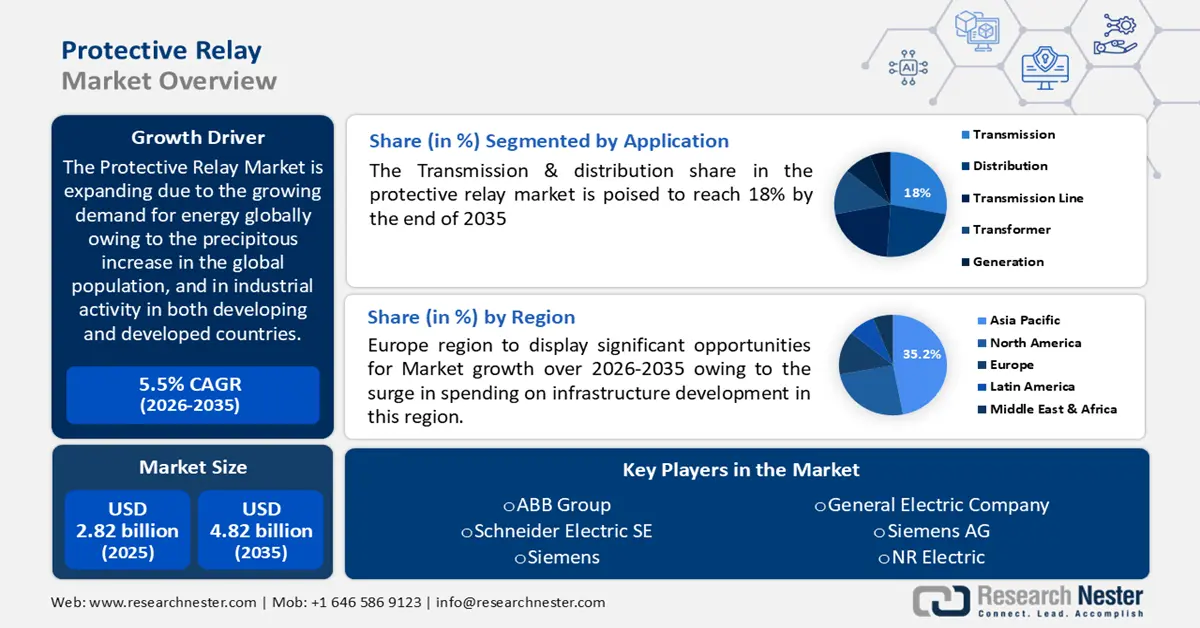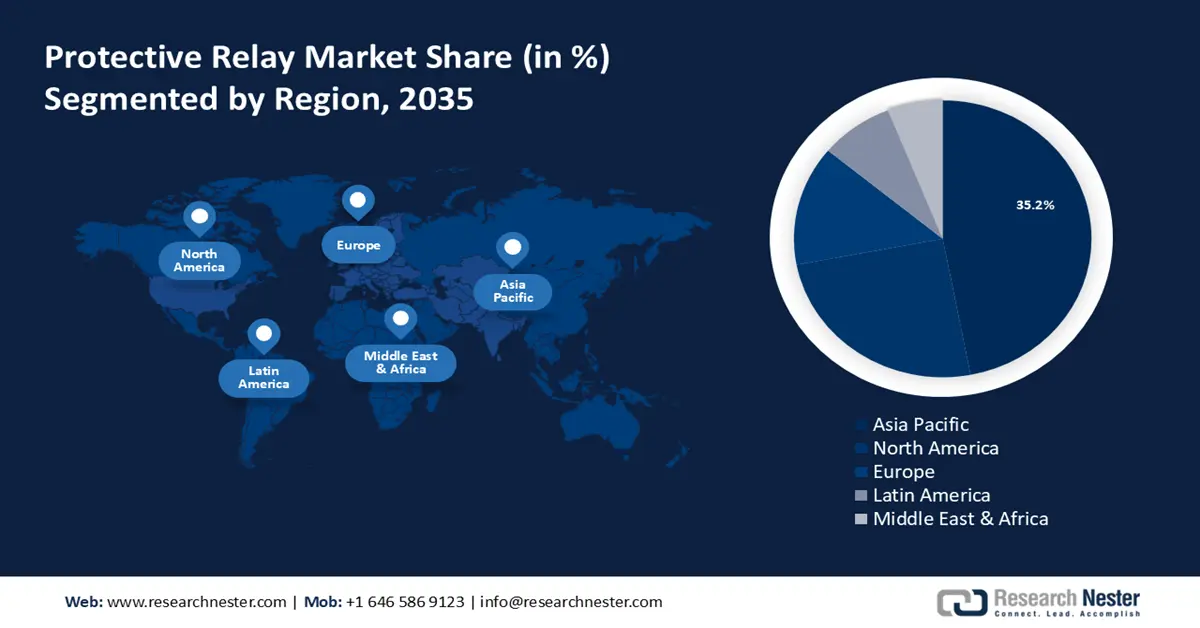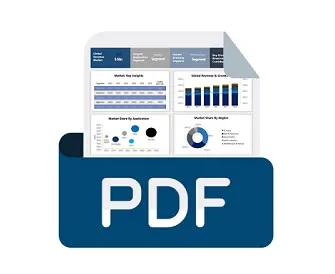Protective Relay Market Outlook:
Protective Relay Market size was over USD 2.82 billion in 2025 and is poised to exceed USD 4.82 billion by 2035, witnessing over 5.5% CAGR during the forecast period i.e., between 2026-2035. In the year 2026, the industry size of protective relay is evaluated at USD 2.96 billion.

The demand for protective relay is set to be influenced by the expansion of the renewable energy infrastructure to detect any dangerous, or intolerable conditions. As per a report published by the International Energy Agency, the capacity of renewable energy in 2023 increased by 50% in contrast to 2022 across the globe. Consequently, the adoption of protective relay is poised to rise.
Key Protective Relay Market Insights Summary:
Regional Highlights:
- Europe protective relay market will hold around 35.20% share by 2035, driven by increasing urban population and rising demand for electricity.
Segment Insights:
- The utilities segment in the protective relay market is forecasted to secure a 32% share by 2035, driven by increased investments in advanced relays for grid reliability, stability, and energy security.
- The transmission & distribution segment in the protective relay market is expected to capture an 18% share by 2035, fueled by rising demand for relay systems to safeguard equipment from overloads and short circuits.
Key Growth Trends:
- Growing adoption of electric vehicles
- Rising integration of digitalization & IoT in protective relay
Major Challenges:
- Growing adoption of electric vehicles
- Rising integration of digitalization & IoT in protective relay
Key Players: Mitsubishi Electric Corporation, ABB Ltd., Littelfuse Inc, Toshiba Corporation, Schneider Electric, Siemens AG, Bender GmbH & Co. KG, Eaton Corporation PLC, Texas Instruments Incorporated.
Global Protective Relay Market Forecast and Regional Outlook:
Market Size & Growth Projections:
- 2025 Market Size: USD 2.82 billion
- 2026 Market Size: USD 2.96 billion
- Projected Market Size: USD 4.82 billion by 2035
- Growth Forecasts: 5.5% CAGR (2026-2035)
Key Regional Dynamics:
- Largest Region: Europe (35.2% Share by 2035)
- Fastest Growing Region: Asia Pacific
- Dominating Countries: United States, China, Germany, Japan, India
- Emerging Countries: China, India, Japan, South Korea, Brazil
Last updated on : 8 September, 2025
Protective Relay Market Growth Drivers and Challenges:
Growth Drivers
- Growing adoption of electric vehicles - As per the estimations of EIA, approximately 10 million electric cars will be sold across the globe in 2022 and are anticipated to rise by an additional 35% in 2023 to reach 14 million. Hence, the protective relay market demand is predicted to grow. This is because safety is the major concern in electric vehicles.
Furthermore, the prevalence of electric vehicle disease has also grown in number. The adoption of protective relays is set to rise since they connect or isolate automobiles from the charger while ensuring user safety by handling dangerous conditions such as ground faults or creepage currents.
- Rising integration of digitalization & IoT in protective relay - The development of distributed energy resources (DER) systems has brought about an inevitable increase in the level of complexity of grid operations. However, more mature economies have demonstrated significantly higher densities of DER.
DER integration and management seeks to shift away from human-controlled DER management system software (DERMS) and towards something more comparable to the Energy Internet of Things (eIOT), without any arbitrary upper restrictions on DER density. Thus, digitization provides real-time monitoring, control, and optimization of energy usage and production. Digitalization has an opportunity to sustain the electric grid in numerous ways including advanced energy management systems, growing trading of energy, and more.
- Surge in the number of aging electronic infrastructure - The worldwide electrical infrastructure is presently aging and being utilized beyond its original capability. The International Energy Agency (IEA) recently published an analysis suggesting that governments and services around the world have to replace or add roughly 50 million miles (80 million kilometers) of electrical grids by 2040 to ensure reliable electricity supply while tackling power sector pollution. As a result, the importance of the protective relay market is predicted to increase.
Challenges
- Growing complexity in installing a protective relay - The testing and verification of protective devices and arrangements involves several concerns. This emerges since the primary function of protective devices is to function during fault conditions, and these devices cannot be properly tested under normal functioning conditions.
The problem is exacerbated by the rising complexity of protection arrangements, the application of protection relays with significant software features, and the often-utilized Ethernet peer-to-peer logic.
- Rising threat of cyber attacks - Recently, the power system underwent a digital shift by combining the use of information and communication technologies (ICTs), smart meters, and the Internet of Things (IoTs), resulting in the establishment of cyber-physical power system (CPPS) networks.
This shift, however, has raised the vulnerability of power system networks to cyberattacks as well as privacy concerns, as management and safety decisions rely primarily on data reliability.
Fluctuations in price of raw materials - The prices of raw materials for protective relays are affected by supply and demand trends. Raw material supply fluctuations may lead to price volatility. Natural disasters, geopolitical disruptions, worldwide emergencies, and economic situations may all have an impact on the supply chain, causing raw material pricing changes.
Protective Relay Market Size and Forecast:
| Report Attribute | Details |
|---|---|
|
Base Year |
2025 |
|
Forecast Period |
2026-2035 |
|
CAGR |
5.5% |
|
Base Year Market Size (2025) |
USD 2.82 billion |
|
Forecast Year Market Size (2035) |
USD 4.82 billion |
|
Regional Scope |
|
Protective Relay Market Segmentation:
Application Segment Analysis
Transmission & distribution segment share in the protective relay market is poised to reach 18% by the end of 2035. The use of protective relays in transmission and distribution networks is expected to rise substantially in the coming years. Relays such as these provide a significant function in protecting lines, transformers, and other equipment against problems such as overloads, short circuits, and electrical irregularities.
Moreover, according to the IEA, around the world demand for energy is projected to grow at an average yearly pace of 3.4% through 2026, fueled by economic expansion and electrification efforts, emphasizing the need for efficient safety measures. Consequently, with the growth in this segment, the protective relay market is poised to rise.
End-User Segment Analysis
In protective relay market, utilities segment share is estimated to cross 32% by 2035. Protective relays detect malfunctioning devices and hazardous conditions, maintaining the electrical grid's safety and reliability.
In addition, the growing focus on energy security and the need to control the fluctuation of renewable energy sources requires smarter and more connected grids, which increases the need for protective relay systems. Utilities are making investments in high-quality control and protection relays to increase grid stability, reliability, and efficiency.
Furthermore, the residential & commercial segment is also set to grow at the highest CAGR over the forecast period. This growth of the segment is expected to be encouraged by growing residential and commercial infrastructure which is further boosting the need for energy. For instance, in 2022 there were approximately 93,000 office buildings across the globe.
Our in-depth analysis of the market includes the following segments:
|
Product Type |
|
|
Application |
|
|
End-User |
|

Vishnu Nair
Head - Global Business DevelopmentCustomize this report to your requirements — connect with our consultant for personalized insights and options.
Protective Relay Market Regional Analysis:
European Market Insights
Europe industry is estimated to dominate majority revenue share of 35.2% by 2035. This growth of the market in this region is poised to be dominated by a rising urban population. For instance, the European Commission states that in 2021, over 38.9% of the individuals were residing in urban areas. Hence, this has further boosted the demand for electricity in this region.
Among this region, the market for protective relay is the UK is predicted to generate a revenue of USD 5.33 billion for the year 2035 which is also the highest compared to all other nations in Europe. This growth is set to be driven by the growing production of wind energy in this region.
Moreover, the German market is also projected to have exponential growth in this region owing to growing investment in smart grid adoption.
Furthermore, with the rise in net zero initiatives the market for protective relay in France is additionally projected to rise at a faster pace over the forecast period.
Latin America Market Insights
The Latin America protective relay market is expected to expand over the forecast period. The major element to influence the market growth in this region is the growing electricity generated by hydro plants. As per the EIA report, hydropower is the major source to generate electricity in most countries in Latin America, accounting for 45% of the electricity supply from the region in total. As a cause of this factor, the demand for protective relay is predicted to experience a surge in this region.
Further, the Brazilian market for the protective relay in this region is poised to observe a rise in revenue amounting to USD 1.48 by the end of 2035. This could be owing to the rise in population in this region.
Moreover, the market in Mexico for protective relay is also estimated to rise along with Brazil owing to the rising funding to this nation to build efficient power supply sources.
Additionally, Argentina nation is experiencing a rise in non-hydro renewable projects which is further predicted to expand the market for protective relay in this area.

Protective Relay Market Players:
- Mitsubishi Electric Corporation
- Company Overview
- Business Strategy
- Key Product Offerings
- Financial Performance
- Key Performance Indicators
- Risk Analysis
- Recent Development
- Regional Presence
- SWOT Analysis
- ABB Ltd.
- Littelfuse Inc
- Toshiba Corporation
- Schneider Electric
- Siemens AG
- Bender GmbH & Co. KG
- Eaton Corporation PLC
- Texas Instruments Incorporated
The market for protective relays is set to expand owing to the presence of number of a key player who are continuously working on a number of initiatives to boost their product performance. These key players include:
Recent Developments
- February 22, 2023: ABB launched the Relay Retrofit Program, initiating the advancement of select SPACOM protection relays to the enhanced REX610 technology. REX610 is considered an all-in-one protection relay, that provides flexibility, sustainability, and future readiness for evolving power grids.
- July 5, 2023: Littelfuse, Inc, announced the launch of its AEC-Q200 Rev E Qualified Fuses, especially constructed for the demanding circuit protection need of compact vehicle electronics and electric vehicle (EV) applications.
- Report ID: 2579
- Published Date: Sep 08, 2025
- Report Format: PDF, PPT
- Get detailed insights on specific segments/region
- Inquire about report customization for your industry
- Learn about our special pricing for startups
- Request a demo of the report’s key findings
- Understand the report’s forecasting methodology
- Inquire about post-purchase support and updates
- Ask About Company-Level Intelligence Additions
Have specific data needs or budget constraints?
Frequently Asked Questions (FAQ)
Protective Relay Market Report Scope
FREE Sample Copy includes market overview, growth trends, statistical charts & tables, forecast estimates, and much more.
Connect with our Expert
See how top U.S. companies are managing market uncertainty — get your free sample with trends, challenges, macroeconomic factors, charts, forecasts, and more.
Copyright @ 2025 Research Nester. All Rights Reserved.

 Inquiry Before Buying
Inquiry Before Buying


 Afghanistan (+93)
Afghanistan (+93)
 Åland Islands (+358)
Åland Islands (+358)
 Albania (+355)
Albania (+355)
 Algeria (+213)
Algeria (+213)
 American Samoa (+1684)
American Samoa (+1684)
 Andorra (+376)
Andorra (+376)
 Angola (+244)
Angola (+244)
 Anguilla (+1264)
Anguilla (+1264)
 Antarctica (+672)
Antarctica (+672)
 Antigua and Barbuda (+1268)
Antigua and Barbuda (+1268)
 Argentina (+54)
Argentina (+54)
 Armenia (+374)
Armenia (+374)
 Aruba (+297)
Aruba (+297)
 Australia (+61)
Australia (+61)
 Austria (+43)
Austria (+43)
 Azerbaijan (+994)
Azerbaijan (+994)
 Bahamas (+1242)
Bahamas (+1242)
 Bahrain (+973)
Bahrain (+973)
 Bangladesh (+880)
Bangladesh (+880)
 Barbados (+1246)
Barbados (+1246)
 Belarus (+375)
Belarus (+375)
 Belgium (+32)
Belgium (+32)
 Belize (+501)
Belize (+501)
 Benin (+229)
Benin (+229)
 Bermuda (+1441)
Bermuda (+1441)
 Bhutan (+975)
Bhutan (+975)
 Bolivia (+591)
Bolivia (+591)
 Bosnia and Herzegovina (+387)
Bosnia and Herzegovina (+387)
 Botswana (+267)
Botswana (+267)
 Bouvet Island (+)
Bouvet Island (+)
 Brazil (+55)
Brazil (+55)
 British Indian Ocean Territory (+246)
British Indian Ocean Territory (+246)
 British Virgin Islands (+1284)
British Virgin Islands (+1284)
 Brunei (+673)
Brunei (+673)
 Bulgaria (+359)
Bulgaria (+359)
 Burkina Faso (+226)
Burkina Faso (+226)
 Burundi (+257)
Burundi (+257)
 Cambodia (+855)
Cambodia (+855)
 Cameroon (+237)
Cameroon (+237)
 Canada (+1)
Canada (+1)
 Cape Verde (+238)
Cape Verde (+238)
 Cayman Islands (+1345)
Cayman Islands (+1345)
 Central African Republic (+236)
Central African Republic (+236)
 Chad (+235)
Chad (+235)
 Chile (+56)
Chile (+56)
 China (+86)
China (+86)
 Christmas Island (+61)
Christmas Island (+61)
 Cocos (Keeling) Islands (+61)
Cocos (Keeling) Islands (+61)
 Colombia (+57)
Colombia (+57)
 Comoros (+269)
Comoros (+269)
 Cook Islands (+682)
Cook Islands (+682)
 Costa Rica (+506)
Costa Rica (+506)
 Croatia (+385)
Croatia (+385)
 Cuba (+53)
Cuba (+53)
 Curaçao (+599)
Curaçao (+599)
 Cyprus (+357)
Cyprus (+357)
 Czechia (+420)
Czechia (+420)
 Democratic Republic of the Congo (+243)
Democratic Republic of the Congo (+243)
 Denmark (+45)
Denmark (+45)
 Djibouti (+253)
Djibouti (+253)
 Dominica (+1767)
Dominica (+1767)
 Dominican Republic (+1809)
Dominican Republic (+1809)
 Timor-Leste (+670)
Timor-Leste (+670)
 Ecuador (+593)
Ecuador (+593)
 Egypt (+20)
Egypt (+20)
 El Salvador (+503)
El Salvador (+503)
 Equatorial Guinea (+240)
Equatorial Guinea (+240)
 Eritrea (+291)
Eritrea (+291)
 Estonia (+372)
Estonia (+372)
 Ethiopia (+251)
Ethiopia (+251)
 Falkland Islands (+500)
Falkland Islands (+500)
 Faroe Islands (+298)
Faroe Islands (+298)
 Fiji (+679)
Fiji (+679)
 Finland (+358)
Finland (+358)
 France (+33)
France (+33)
 Gabon (+241)
Gabon (+241)
 Gambia (+220)
Gambia (+220)
 Georgia (+995)
Georgia (+995)
 Germany (+49)
Germany (+49)
 Ghana (+233)
Ghana (+233)
 Gibraltar (+350)
Gibraltar (+350)
 Greece (+30)
Greece (+30)
 Greenland (+299)
Greenland (+299)
 Grenada (+1473)
Grenada (+1473)
 Guadeloupe (+590)
Guadeloupe (+590)
 Guam (+1671)
Guam (+1671)
 Guatemala (+502)
Guatemala (+502)
 Guinea (+224)
Guinea (+224)
 Guinea-Bissau (+245)
Guinea-Bissau (+245)
 Guyana (+592)
Guyana (+592)
 Haiti (+509)
Haiti (+509)
 Honduras (+504)
Honduras (+504)
 Hong Kong (+852)
Hong Kong (+852)
 Hungary (+36)
Hungary (+36)
 Iceland (+354)
Iceland (+354)
 India (+91)
India (+91)
 Indonesia (+62)
Indonesia (+62)
 Iran (+98)
Iran (+98)
 Iraq (+964)
Iraq (+964)
 Ireland (+353)
Ireland (+353)
 Isle of Man (+44)
Isle of Man (+44)
 Israel (+972)
Israel (+972)
 Italy (+39)
Italy (+39)
 Jamaica (+1876)
Jamaica (+1876)
 Japan (+81)
Japan (+81)
 Jersey (+44)
Jersey (+44)
 Jordan (+962)
Jordan (+962)
 Kazakhstan (+7)
Kazakhstan (+7)
 Kenya (+254)
Kenya (+254)
 Kiribati (+686)
Kiribati (+686)
 Kuwait (+965)
Kuwait (+965)
 Kyrgyzstan (+996)
Kyrgyzstan (+996)
 Laos (+856)
Laos (+856)
 Latvia (+371)
Latvia (+371)
 Lebanon (+961)
Lebanon (+961)
 Lesotho (+266)
Lesotho (+266)
 Liberia (+231)
Liberia (+231)
 Libya (+218)
Libya (+218)
 Liechtenstein (+423)
Liechtenstein (+423)
 Lithuania (+370)
Lithuania (+370)
 Luxembourg (+352)
Luxembourg (+352)
 Macao (+853)
Macao (+853)
 Madagascar (+261)
Madagascar (+261)
 Malawi (+265)
Malawi (+265)
 Malaysia (+60)
Malaysia (+60)
 Maldives (+960)
Maldives (+960)
 Mali (+223)
Mali (+223)
 Malta (+356)
Malta (+356)
 Marshall Islands (+692)
Marshall Islands (+692)
 Mauritania (+222)
Mauritania (+222)
 Mauritius (+230)
Mauritius (+230)
 Mayotte (+262)
Mayotte (+262)
 Mexico (+52)
Mexico (+52)
 Micronesia (+691)
Micronesia (+691)
 Moldova (+373)
Moldova (+373)
 Monaco (+377)
Monaco (+377)
 Mongolia (+976)
Mongolia (+976)
 Montenegro (+382)
Montenegro (+382)
 Montserrat (+1664)
Montserrat (+1664)
 Morocco (+212)
Morocco (+212)
 Mozambique (+258)
Mozambique (+258)
 Myanmar (+95)
Myanmar (+95)
 Namibia (+264)
Namibia (+264)
 Nauru (+674)
Nauru (+674)
 Nepal (+977)
Nepal (+977)
 Netherlands (+31)
Netherlands (+31)
 New Caledonia (+687)
New Caledonia (+687)
 New Zealand (+64)
New Zealand (+64)
 Nicaragua (+505)
Nicaragua (+505)
 Niger (+227)
Niger (+227)
 Nigeria (+234)
Nigeria (+234)
 Niue (+683)
Niue (+683)
 Norfolk Island (+672)
Norfolk Island (+672)
 North Korea (+850)
North Korea (+850)
 Northern Mariana Islands (+1670)
Northern Mariana Islands (+1670)
 Norway (+47)
Norway (+47)
 Oman (+968)
Oman (+968)
 Pakistan (+92)
Pakistan (+92)
 Palau (+680)
Palau (+680)
 Palestine (+970)
Palestine (+970)
 Panama (+507)
Panama (+507)
 Papua New Guinea (+675)
Papua New Guinea (+675)
 Paraguay (+595)
Paraguay (+595)
 Peru (+51)
Peru (+51)
 Philippines (+63)
Philippines (+63)
 Poland (+48)
Poland (+48)
 Portugal (+351)
Portugal (+351)
 Puerto Rico (+1787)
Puerto Rico (+1787)
 Qatar (+974)
Qatar (+974)
 Romania (+40)
Romania (+40)
 Russia (+7)
Russia (+7)
 Rwanda (+250)
Rwanda (+250)
 Saint Barthélemy (+590)
Saint Barthélemy (+590)
 Saint Helena, Ascension and Tristan da Cunha (+290)
Saint Helena, Ascension and Tristan da Cunha (+290)
 Saint Kitts and Nevis (+1869)
Saint Kitts and Nevis (+1869)
 Saint Lucia (+1758)
Saint Lucia (+1758)
 Saint Martin (French part) (+590)
Saint Martin (French part) (+590)
 Saint Pierre and Miquelon (+508)
Saint Pierre and Miquelon (+508)
 Saint Vincent and the Grenadines (+1784)
Saint Vincent and the Grenadines (+1784)
 Samoa (+685)
Samoa (+685)
 San Marino (+378)
San Marino (+378)
 Sao Tome and Principe (+239)
Sao Tome and Principe (+239)
 Saudi Arabia (+966)
Saudi Arabia (+966)
 Senegal (+221)
Senegal (+221)
 Serbia (+381)
Serbia (+381)
 Seychelles (+248)
Seychelles (+248)
 Sierra Leone (+232)
Sierra Leone (+232)
 Singapore (+65)
Singapore (+65)
 Sint Maarten (Dutch part) (+1721)
Sint Maarten (Dutch part) (+1721)
 Slovakia (+421)
Slovakia (+421)
 Slovenia (+386)
Slovenia (+386)
 Solomon Islands (+677)
Solomon Islands (+677)
 Somalia (+252)
Somalia (+252)
 South Africa (+27)
South Africa (+27)
 South Georgia and the South Sandwich Islands (+0)
South Georgia and the South Sandwich Islands (+0)
 South Korea (+82)
South Korea (+82)
 South Sudan (+211)
South Sudan (+211)
 Spain (+34)
Spain (+34)
 Sri Lanka (+94)
Sri Lanka (+94)
 Sudan (+249)
Sudan (+249)
 Suriname (+597)
Suriname (+597)
 Svalbard and Jan Mayen (+47)
Svalbard and Jan Mayen (+47)
 Eswatini (+268)
Eswatini (+268)
 Sweden (+46)
Sweden (+46)
 Switzerland (+41)
Switzerland (+41)
 Syria (+963)
Syria (+963)
 Taiwan (+886)
Taiwan (+886)
 Tajikistan (+992)
Tajikistan (+992)
 Tanzania (+255)
Tanzania (+255)
 Thailand (+66)
Thailand (+66)
 Togo (+228)
Togo (+228)
 Tokelau (+690)
Tokelau (+690)
 Tonga (+676)
Tonga (+676)
 Trinidad and Tobago (+1868)
Trinidad and Tobago (+1868)
 Tunisia (+216)
Tunisia (+216)
 Turkey (+90)
Turkey (+90)
 Turkmenistan (+993)
Turkmenistan (+993)
 Turks and Caicos Islands (+1649)
Turks and Caicos Islands (+1649)
 Tuvalu (+688)
Tuvalu (+688)
 Uganda (+256)
Uganda (+256)
 Ukraine (+380)
Ukraine (+380)
 United Arab Emirates (+971)
United Arab Emirates (+971)
 United Kingdom (+44)
United Kingdom (+44)
 Uruguay (+598)
Uruguay (+598)
 Uzbekistan (+998)
Uzbekistan (+998)
 Vanuatu (+678)
Vanuatu (+678)
 Vatican City (+39)
Vatican City (+39)
 Venezuela (Bolivarian Republic of) (+58)
Venezuela (Bolivarian Republic of) (+58)
 Vietnam (+84)
Vietnam (+84)
 Wallis and Futuna (+681)
Wallis and Futuna (+681)
 Western Sahara (+212)
Western Sahara (+212)
 Yemen (+967)
Yemen (+967)
 Zambia (+260)
Zambia (+260)
 Zimbabwe (+263)
Zimbabwe (+263)
